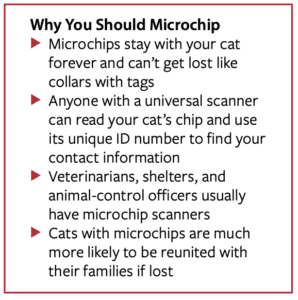Microchips are increasingly common in dogs these days, and we think this should become standard for cats as well, including indoor cats who can accidentally escape into the great outdoors.
A microchip is a small “chip” about the size of a grain of rice that is implanted under the skin, usually near the top of the shoulder blades. Once implanted, it is permanent identification.
Each microchip has a unique number that can be read with a microchip scanner using RFID technology. When the scanner is near, it energizes the chip to send the number to the scanner via radio waves. The microchip itself does not have an energy source.
Once someone has scanned the chip, they can look up its unique number to find the owner’s contact information.
Microchips will last the entire life of your cat, and unlike collars and tags, they cannot fall off or become lost.
Registration Is Critical
When a microchip is implanted by a veterinarian, breeder, or shelter staff, the chip’s unique number must be registered with the contact information for the cat’s owner. The cat will keep the same microchip number for her entire life, but if she has different owners, the contact info must be changed.
For example, if a cat first gets a microchip in a shelter, the chip will likely be registered with the shelter’s contact info. If you were to adopt the cat, you can contact the company to change the contact information to yours.
the shelter’s contact info. If you were to adopt the cat, you can contact the company to change the contact information to yours.
The microchip is useless if it has not been registered with accurate contact information, because the chip itself does not store contact information. It only stores the unique identification number that is used to look up contact information for a cat.
Choosing a Microchip
Many manufacturers make microchips. Your veterinarian likely works with a particular company and may register the chip for you after implanting it.
If choosing your own microchip, look for a product that works with universal scanners. Some chips can only be read by specialized scanners. You want a chip that any veterinarian, animal shelter, or animal-control officer can quickly and easily scan with a universal scanner.
Some examples of microchip companies include HomeAgain, AKCReunite, and PetLink. Many companies also offer membership programs with various benefits, but once a chip is purchased and registered, your contact info will be in the database forever without an additional fee.
Common Questions
Do microchips have GPS? No. You cannot track a microchip from afar.
Are microchips radioactive? No, microchips do not use radiation.
Can microchips move? Yes. They can migrate under the skin. Most chips stay in place, but they can travel down the pet’s back or down the side toward one of the front legs. It is important to scan the entire body for a microchip.
Do microchips hurt? The initial implantation feels just like a vaccination with a large needle and may cause minor discomfort. After this relatively benign procedure, microchips are not painful. It is rare for pets to have reactions to the microchip itself.
Do I have to register my cat’s microchip? Yes. You must register the microchip so that it can be used to access your contact information.
Do I have to pay an annual fee? Not usually. Many microchip companies offer memberships with additional features and benefits, but the basic function of the microchip as a means of identifying your pet if she gets lost is free after the initial implantation and registration.




